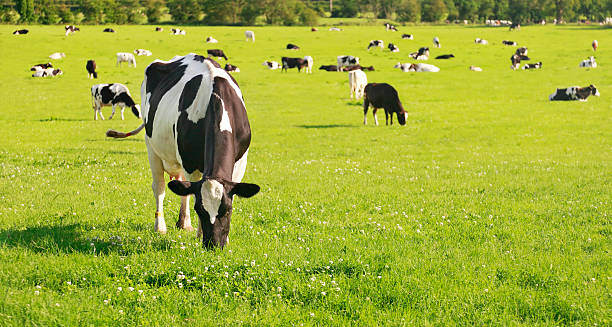In Nature, fibrous feeds can come as a problem if animals are not equipped with specific gear to deal with it. Cell walls from plants are refractory to animal enzymes, and thus indigestible by them. This means that Nature had to, somehow, solve the problem… and the solution appeared as fermentation compartments where a vibrant and complex microbial and fungi population ferments fibrous materials, breaking the complex cell walls from plants. In Ruminants, the stomach is divided into 4 compartments, 2 of them (rumen and reticulum) with high fermentative activity, and because of this they are the ultimate recyclers.
Prefer to listen to this article? Click the play button below and enjoy our podcast!
Cattle Superpower
Ruminants, due to their unique digestive system can digest fibrous materials, rich in cellulose, hemicellulose and other fiber constituents (lignin, silica, etc) that monogastric animals cannot. How does this happen? Cattle eat roughage (grass, hay, silage,…) and it moves into the rumen. Here is where the magic happens, because the cow feeds the microbes, and the microbes in turn feed the cow!

In the rumen a highly complex microbial population composed of several types of bacteria, fungi and protozoa, ferment the feed. During the fermentation process, and as a result of microbial activity, fermentation end products are released, namely volatile fatty acids (VFA). VFA are absorbed through rumen walls and are the main source of energy for the animal. Another byproduct of rumen fermentation is microbial protein (MP). As microbes feed, they grow and microbial population increases. MP represents an important source of protein for the animal. Finally, the less interesting byproduct from fermentation is gas, mainly carbon dioxide and dihydrogen. A specific type of bacteria – methanogens – will take the CO2 and the H2 and create methane – CH4. This gas is then eructated as a waste, and represents a loss of energy for the animal.
After this overview of rumen fermentation, it is clear that ruminants are built to transform non editable biomass for humans into high dense nutritional products for humans, such as meat or milk. Cattle recycle biomass/protein that is not directly usable for human food to produce food of high nutritional quality.
The apparent “low efficiency” of ruminants…
Literature data seems to suggest that ruminants are less efficient than monogastric animals1. The efficiency can vary from 10% (dairy heifers) to 20% in growing and finishing animals and is higher in lactating dairy cows (25 to 30%). It takes more than 3 kg of plant protein to produce 1 kg of milk protein and between 5 and 10 kg of plant protein to produce 1 kg of bovine protein.
In comparison, fattening pig fed diets based on cereals and soybean meal takes on average 3 kg of plant protein to produce 1 kg of animal protein. In broiler production numbers are higher: 2.2 kg of plant protein to make 1 kg of broiler protein on average.
However, one should not only look at “plant protein”. The amount of fiber in diets of monogastrics is nowhere near the one in ruminant diets. Ruminants are fed with forage-rich diets that are much less digestible than diets fed to monogastric animals, and this makes all the difference2.
Upcycling non-edible biomass
As we can see, ruminants are recyclers by nature, they contribute to circularity and to a more efficient and better use of resources by utilizing non-edible biomass, local feed products and new innovative sources of feed while providing organic fertilizers. At least 80% of the nutrients consumed by cattle come from grass, roughage, food processing by-products and other feedstuffs not edible by Humans. This is extended to all livestock production systems if one shifts from a linear to a circular agri-food system3

Fig. 1 – From linear to circular agri-food system (ATF, 2019)
One should also have in mind that meat or milk provide humans with other nutrients besides protein. Beef is described as nutrient-dense providing consumers with large amounts of daily requirements for protein, vitamin B-12, iron, zinc and other essential nutrients. Bovine milk and dairy products represent a very good source of proteins, lipids, vitamins and minerals.
And this is their superpower: upcycling non-edible feed into high nutritional food products for humans.

Take Home messages
Cattle provide nutrient-rich, safe, and healthy food for humans of high nutritional quality and safety, responding to an increasingly diverse demand. They contribute to greater agriculture, food and nutrition security with reduced environmental impacts by prioritizing the use of non-human-edible biomass for feed, such as grasslands, forages, by-products of the food-chain, former food, and waste.
References
1. Peyraud J.L., Cellier P., Aarts F., Béline F., Bockstaller C., Bourblanc M., Delaby L., Dourmad J.Y., Dupraz P., Durand P., Faverdin P., Fiorelli J.L., Gaigné C., Kuikman P., Langlais A., Le Goffe P., Lescoat P., Morvan T., Nicourt C., Parnaudeau V., Rochette P., Vertes F., Veysset P., Rechauchere, O. and Donnars C. (2014). Nitrogen flows and livestock farming: lessons and perspectives. Advance in Animal Biosciences 5, special issue 1, 59-69
2. Jean-Louis Peyraud, A. Peeters. The role of grassland based production system in the protein security. 26. General meeting of the European Grassland Federation (EGF), Sep 2016, Trondheim, Norway. ffhal-02743435f
3. Animal Task Force, 2019. Vision Paper: towards European Research and Innovation for a sustainable and competitive livestock production sector in Europe. A framework for suggested priorities for R&I within Horizon Europe. February 2019
About the author
Ana Sofia Santos (Head of Research and Innovation at FeedInov CoLAB)
Ana Sofia Santos holds a MSc in Animal Production and a PhD in Animal Science, both on the Nutrition area. She is currently Head of research and Innovation at FeedInov CoLAB, an interface structure between the academia and the animal feed industry, promoting innovative approaches to animal feeding. Her current area of research interest resides on animal production systems and the integration of livestock and plant production systems within a holistic vision of circularity in food production.
Explore author’s articles



Leave your comments here